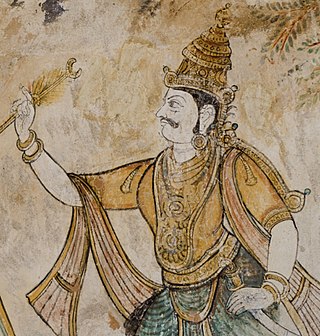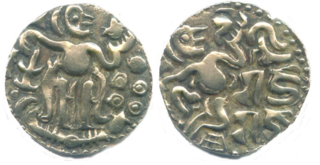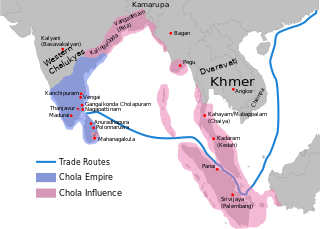Related Research Articles

Srivijaya was a Buddhist thalassocratic empire based on the island of Sumatra, which influenced much of Southeast Asia. Srivijaya was an important centre for the expansion of Buddhism from the 7th to the 11th century AD. Srivijaya was the first polity to dominate much of western Maritime Southeast Asia. Due to its location, the Srivijaya developed complex technology utilizing maritime resources. In addition, its economy became progressively reliant on the booming trade in the region, thus transforming it into a prestige goods-based economy.

Rajaraja I, often described as Rajaraja the Great was a Tamil Chola emperor who reigned from 985 CE to 1014 CE. An iconic figure and regarded as the 'King of Kings', he was the most powerful king in South India during his reign and is remembered for reinstating the Chola influence and ensuring its supremacy across the Indian Ocean.

Kulottunga I also spelt Kulothunga, born Rajendra Chalukya, was a Chola Emperor who reigned from 1070 CE to 1122 CE succeeding his cousin Athirajendra Chola. He also served as the Eastern Chalukya king from 1061 CE to 1118 CE, succeeding his father Rajaraja Narendra. He is related to the Chola dynasty through his mother's side and the Eastern Chalukyas through his father's side. His mother, Ammangaidevi, was a Chola princess and the daughter of emperor Rajendra I. His father was king Rajaraja Narendra of the Eastern Chalukya dynasty who was the nephew of Rajendra I and maternal grandson of Rajaraja I. According to historian Sailendra Nath Sen, his accession marked the beginning of a new era and ushered in a period of internal peace and benevolent administration.

The Shailendra dynasty was the name of a notable Indianised dynasty that emerged in 8th-century Java, whose reign signified a cultural renaissance in the region. The Shailendras were active promoters of Mahayana Buddhism with the glimpses of Hinduism, and covered the Kedu Plain of Central Java with Buddhist monuments, one of which is the colossal stupa of Borobudur, now a UNESCO World Heritage Site.
Rajendra I(/rɑːdʒeɪndrə/; Middle Tamil: Rājēntira Cōḻaṉ; Classical Sanskrit: Rājēndradēva Cōla; Old Malay: Raja Suran; c. 971 CE – 1044 CE), often referred to as Rajendra the Great, and also known as Gangaikonda Cholan, and Kadaram Kondan was a Chola Emperor who reigned from 1014 and 1044 CE. He is considered the most significant ruler in early eleventh-century South Asia for his role in patronizing the arts, encouraging trade, influential diplomacy, military conquest, and expanding the Chola Empire to its greatest extent.

Suryavarman I was king of the Khmer Empire from 1006 to 1050. Suryavarman usurped King Udayadityavarman I, defeating his armies in approximately 1002. After a protracted war with Udayadityavarman's would-be successor, Jayavirahvarman, Suryavarman I claimed the throne in 1010. Suryavarman was a Mahayana Buddhist who was also tolerant of the growing Theravada Buddhist presence in the Khmer kingdom.

Rajadhiraja I was a Chola emperor, the most skilled military commander among the Chola rulers and the successor of his father, Rajendra I. He was the only Chola emperor who was killed while leading his army in war, and although he had a short reign, he helped his father conquer several territories as well as to maintain the Chola authority over most of Sri Lanka, Eastern Chalukya and Kalinga, among others. He also established imperial relations with overseas allies despite a series of revolts in the territory.

The Chola dynasty was a Tamil Thalassocratic empire of Tamilakam and was one of the longest-ruling dynasties in the world history. The earliest datable references to the Chola are from inscriptions dated to the 3rd century BCE during the reign of Ashoka of the Maurya Empire. As one of the Three Crowned Kings of Tamilakam, along with the Chera and Pandya, the dynasty continued to govern over varying territories until the 13th century CE. The Chola Empire was at its peak and achieved imperialism under the Medieval Cholas in the mid-9th century CE. Related dynasties are Telugu Chodas of Andhra, Chodagangas of Kalinga, Nidugal Cholas of Karnataka, Rajahnate of Cebu, Rajahnate of Sanmalan.

Rajendra II often referred to as Rajendradeva Chola was a Chola emperor who reigned from 1052 CE to 1064 CE. He was made Rajendra succeeded his brother Rajadhiraja I after his death at the Battle of Koppam. Rajendra had served as a Co-regent under his brother from 1044 CE to 1052 CE. When he acceded the throne, the Chola Empire was at its peak stretching from Southern India to Vengai(Bengal) to parts of Southeast Asia. Rajendra has maintained the territories of his predecessor. During his reign, the Chola Empire was prosperous and had a large influence in trade throughout the Indian Ocean.

Virarajendra Chola was a Chola emperor, who spent a major part of his life as a subordinate to two of his elder brothers Rajadhiraja I and Rajendra II, he is the son of Rajendra I. During his early reign he granted the maintenance of a school to study the Vedas, Sastras and grammar; a hostel was provided for the students. A hospital named Virasolan was also provided by him for the sick people. The famous grammatical work in Tamil, Virasoliyam was written by Buddhamitra during his reign.
The Cholas did not have a standing navy in the modern sense. The maritime force of Cholas was formed by using ships used for trade, as they did not have a dedicated ship for naval combat. The ships were used for transporting the land army overseas.

Inscriptions and historical sources assert that the Medieval Chola Emperor Rajendra Chola I sent a naval expedition to Indochina, the Indonesia and Malay Peninsula in 1025 in order to subdue Srivijaya. The Thiruvalangadu plates, the Leyden grant, and the Tamil stele of Rajendra Chola I are the principal sources of information about the campaign.

Southeast Asia was in the Indian sphere of cultural influence from 290 BCE to the 15th century CE, when Hindu-Buddhist influences were incorporated into local political systems. Kingdoms in the southeast coast of the Indian Subcontinent had established trade, cultural and political relations with Southeast Asian kingdoms in Burma, Bhutan, Sri Lanka, Thailand, Indonesia, Malay Peninsula, Philippines, Cambodia and Champa. This led to the Indianisation and Sanskritisation of Southeast Asia within the Indosphere, Southeast Asian polities were the Indianised Hindu-Buddhist Mandala.

Kahuripan was an 11th-century Javanese Hindu-Buddhist kingdom with its capital located around the estuarine of Brantas River valley in East Java. The kingdom was short-lived, only spanning the period between 1019 and 1045, and Airlangga was the only raja of the kingdom, which was built out of the rubble of the Kingdom of Mataram after the Srivijaya invasion. Airlangga later in 1045 abdicated in favour of his two sons and divided the kingdom into Janggala and Panjalu (Kadiri). The kingdom's name derived from Old Javanese term hurip with circumfix ka- -an which means "life" or "livelihood". Later in 14th to 15th century, the former kingdom was recognised as one of Majapahit's 12 provinces.

In 1025 CE, the Chola Emperor Rajendra I launched naval raids on Srivijaya in maritime Southeast Asia, Rajendra's overseas expedition against Srivijaya was a unique event in India's history and its otherwise peaceful relations with the states of Southeast Asia. Several places in present-day Indonesia and Malay Peninsula were invaded by Rajendra I of the Chola dynasty. The Chola invasion furthered the expansion of Tamil merchant associations such as the Manigramam, Ayyavole and Ainnurruvar into Southeast Asia. The Cholan invasion led to the fall of the Sailendra Dynasty of Srivijaya and the Chola invasion also coincides with return voyage of the great Buddhist scholar Atiśa from Sumatra to India and Tibet in 1025 CE.

Pannai, Panai or Pane was a Buddhist kingdom located on the east coast of Northern Sumatra that existed between the 11th and 14th centuries. The kingdom was located on the Barumun River and Panai River valleys, in today's Labuhan Batu and South Tapanuli regencies. Because surviving inscriptions and historical records of this period are scarce, the kingdom is among the least known political entities in Indonesian history. Historians suggest that Pannai was probably a principality or a vassal allied under the Srivijayan mandala and later to Dharmasraya kingdom.
Sri Cudamani Warmadewa or Sri Cudamani Varmadeva or written as Shi-li-zhu-luo-wu-ni-fo-ma-tiao-hua, was an emperor of Srivijaya which belongs to the Sailendra dynasty, who reigned in Palembang in the late 10th century CE. He was known as an able and astute ruler, a clever tactician with shrewd diplomatic skills. His reign was quite renowned since during his period, the kingdom faced a dire crisis; the naval invasion of Javanese Mataram Kingdom. He was the nemesis of King Dharmawangsa of Java.
Sri Deva was a king of Srivijaya Kingdom of Sailendra dynasty, who in 1028 CE sent an envoy to the Chinese Northern Song dynasty. In the chronicle History of Song, his name was recorded as Shih-li Tieh-hua, which may not be his complete title. He ruled shortly after Srivijaya's various territories were attacked by King Rajendra I of the Chola dynasty in 1025 CE, in which King Sangramavijayottunggawarman of Srivijaya was defeated and captured by his opponent. Chola attack was not accompanied by the occupation of the Srivijaya territories.
Haji Sumatrabhumi was a king of the Srivijaya Kingdom who sent envoys to the Chinese Song dynasty in 1017. His name is recorded in Li Tao's Xu Zizhi Tongjian Changbian as Xiachi Suwuzhapumi. The title "Haji" was generally a denomination for a vassal king.
Samara Vijayatunggavarman was the Maharaja of Srivijaya from 1045 CE.
References
- ↑ Muljana, Slamet (2006). F.W. Stapel (ed.). Sriwijaya. PT. LKiS Pelangi Aksara. ISBN 978-979-8451-62-1.
- ↑ Coedes, George (1996). The Indianized States of Southeast Asia. University of Hawaii Press. pp. 142&143. ISBN 978-0824803681.